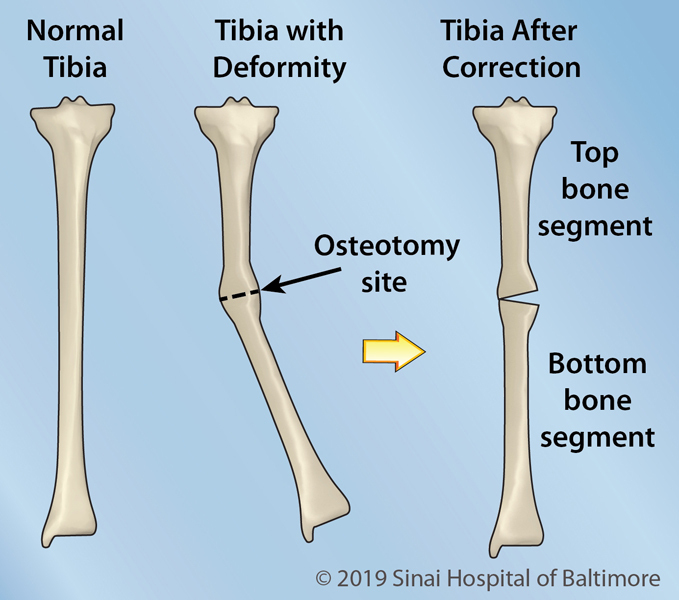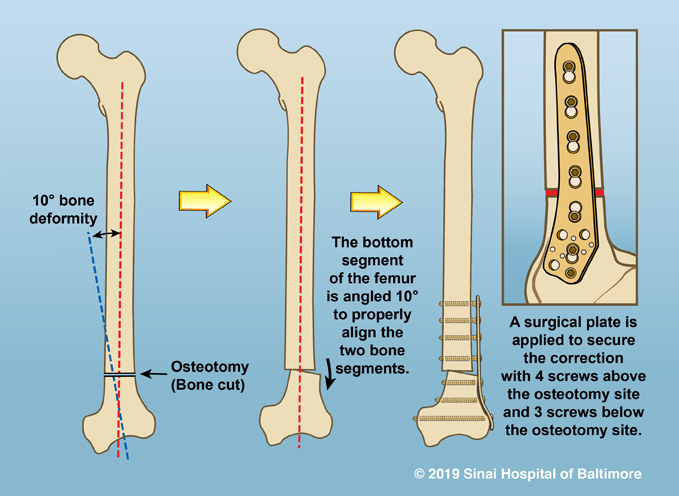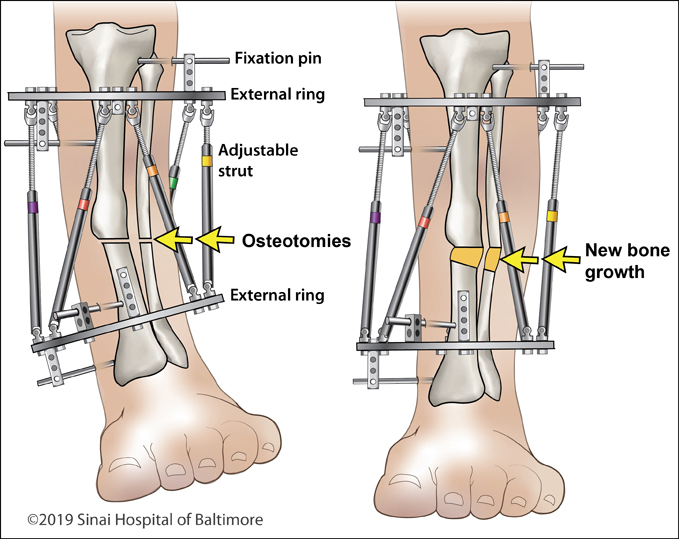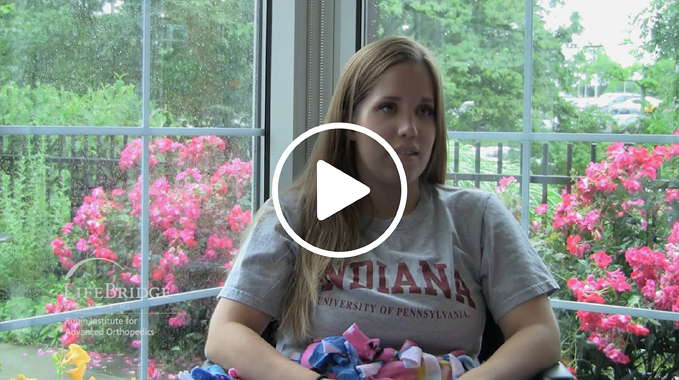Deformity Correction: The Process
What is deformity correction?
Deformity correction is a procedure to straighten a bone that is bent or twisted in a way that is not normal. After the bone is straightened, the arm, leg, or foot has normal alignment and function. Deformities can be corrected in two different ways:
- All at once during a surgical procedure (called acute correction)
- Slowly over the course of several weeks or months (called gradual correction)
The doctor will choose the best approach for each patient based on his/her unique situation. Watch this video to learn about Karie’s journey during her leg-straightening treatment:
How does acute deformity correction work?
During surgery, the doctor makes a cut across the bone to create two separate bone segments. This surgical procedure to cut a bone is called an osteotomy. Then the doctor will straighten the bone.

After the bone is positioned correctly, the doctor inserts an internal device to keep the bone in the corrected position while it heals. The internal device may be an internal nail/rod or a metal plate. Sometimes additional soft-tissue procedures are done at the same time to allow the muscles and nerves to accommodate the correction. After the bone heals, the internal device may be removed during a second surgery.

In some situations, the doctor may use fixator-assisted nailing or fixator-assisted plating to straighten the bone. These two procedures involve temporary application of an external fixator during surgery to hold the bone segments in perfect alignment while an internal nail, rod or plate is applied. The external fixator is then removed at the completion of the surgery, but the internal fixation remains.
How does gradual deformity correction work?
During surgery, an external fixator is applied to the bone. The doctor then cuts the bone (osteotomy) into two separate bone segments and may perform soft-tissue procedures to prepare the muscles and nerves.

After surgery, the patient will be given specific instructions and a schedule for how to adjust the external fixator so that it slowly straightens the bone. This gradual process of slowly separating and straightening the bone segments is called distraction, which means “pulling apart.” As the two bone segments are slowly pulled apart and straightened, new bone forms in the space between them. The new bone is called regenerate bone.
During the distraction phase, the orthopedic device is adjusted daily or even several times a day so that the bone segments are pulled apart and straightened at a slow rate of approximately 1 mm (0.04 inches) per day. This forces the body to constantly grow new bone and soft tissues such as skin, muscles, nerves, and blood vessels. The distraction phase lasts until the bone is straight or corrected. The patient will need to see the doctor every 10 to 14 days during the distraction phase and will start an intensive physical therapy schedule.
The distraction phase is followed by the consolidation phase, where the regenerate bone slowly hardens. The bone is consolidated (“healed”) when the regenerate bone has completely hardened and calcified. The consolidation phase typically takes twice as long as the distraction phase. For example, if distraction is completed in 1 month, then consolidation will take 2 months. This means that in this example, the external fixator would remain on the patient for a total of 3 months through both the distraction and consolidation phases.
To help the bone heal, patients should avoid nicotine in any form, make sure that their diet includes lots of protein, and take vitamin and mineral supplements. During this stage, your doctor may tell you to start putting some weight on the arm/leg, which will also encourage the bone to harden and heal. After the regenerate bone has fully solidified, the external fixator is removed during an outpatient surgical procedure (the patient does not stay in the hospital overnight after the removal procedure).
What types of orthopedic devices can be used for deformity correction?
At the International Center for Limb Lengthening, we use a variety of orthopedic devices to correct bone deformities. We choose which device will work best based on each person’s unique situation. For information about specific devices, please visit Lengthening & Deformity Correction Devices.
What happens if the bone is straightened too slowly during gradual correction?
If the bone is straightened too slowly, the bone may heal before it has been fully straightened. The doctor will want to see the patient often (every 1 to 2 weeks) during the distraction phase to prevent premature consolidation.
Even though the typical rate of correction is 1 mm per day, each person responds differently to bone lengthening. Some people’s bones heal very quickly, and the regenerate bone may harden before treatment is completed. This is called premature consolidation. When the regenerate bone hardens too quickly, the bone may heal before it is completely straight or fully aligned.
The early stages of premature consolidation can be detected on X-rays. When this starts to happen, one option is to increase the rate that the bone segments are pulled apart. For example, the patient may be told to increase the rate of distraction from 1 mm per day up to 2 mm per day. If the regenerate bone has entirely consolidated, the bone may need to be surgically cut again so that lengthening can continue.
What happens if the bone is straightened too quickly during gradual correction?
If the bone is straightened too fast, regenerate bone won’t have time to form. The doctor will want to see the patient often during the distraction phase to make sure that the regenerate bone, muscles, and nerves are responding well to treatment.
Even though the typical rate of distraction is 1 mm per day, some people’s bones take longer to heal. The regenerate bone needs to form during the distraction phase so that it can act as a bridge between the two bone segments.
One non-surgical option when the regenerate bone is not forming is to adjust the orthopedic device to temporarily shorten the bone until the regenerate bone improves to allow the healing to “catch up.” A surgical option to help the body create regenerate bone involves inserting bone tissue (called bone graft) to promote bone growth. After the regenerate begins to fill in between the bone segments, the doctor will allow the patient to continue straightening the bone.
Another issue that can occur during distraction is that the soft tissues (muscles, nerves, ligaments, tendons) may resist being stretched, which can cause them to become very tight. A non-surgical option to treat tight muscles and nerves is to focus on stretching these muscles and nerves during physical therapy sessions. Throughout the distraction process, the patient will be instructed to attend physical therapy multiple times per week. Muscle contractures can also be treated surgically if necessary.
If a nerve is “pinched” or compressed by the distraction process, a surgical procedure called a nerve decompression can be performed which reduces pressure on the nerve.
What could prevent a bone deformity from being corrected?
If patients do not attend physical therapy sessions or perform their home exercises, their muscle strength and range of motion could be affected and the doctor may ask them to stop treatment. Muscle contracture or nerve problems can also cause the doctor to stop the deformity correction process.
Do arms and legs that had deformity correction function well after treatment?
Adults and children typically have very active lives after deformity correction. Our patients have achieved increased function (better walking/gait), improved muscle strength and maintained their range of motion (flexibility). A large part of the success depends on having experienced surgeons, support staff and physical therapists working together with motivated patients through every stage of the process. The role of physical therapy cannot be over-emphasized; patients may need to attend physical therapy sessions multiple times per week to maintain range of motion (flexibility) and muscle strength during the distraction phase. Our physical therapists have years of experience in this highly specialized type of therapy and have developed unique methods and splints geared to make the treatment more successful.
Why choose the International Center for Limb Lengthening?
The International Center for Limb Lengthening is world-renowned for its expertise in limb deformity correction. Your doctor at the International Center for Limb Lengthening will take the time to make sure you understand all of your options and then will customize your treatment to meet your specific needs. Our patients benefit from our team-centered approach with world-renowned pediatric and adult orthopedic surgeons and specialized physician assistants, nurses and physical therapists. We help patients in need of deformity correction achieve their best possible result.

